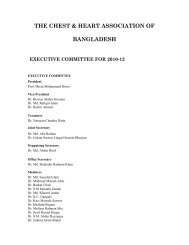Volume. 35, No. 2 july. 2011 - The Chest and Heart Association of ...
Volume. 35, No. 2 july. 2011 - The Chest and Heart Association of ...
Volume. 35, No. 2 july. 2011 - The Chest and Heart Association of ...
Create successful ePaper yourself
Turn your PDF publications into a flip-book with our unique Google optimized e-Paper software.
Study <strong>of</strong> Direct Antiglobulin Test among the Patients ReceivingFarhana Islam et al.Introduction:Drug induced antibody may coat red cell surfacewhich may cause premature destruction <strong>of</strong> redblood cells, resulting anaemia. Drug inducedimmune haemolytic anaemia is an acquired form<strong>of</strong> immune haemolytic anaemia caused by theinteraction <strong>of</strong> certain medications with patientsimmune system 1 . This interaction induced theproduction <strong>of</strong> antibodies that damage red cells <strong>and</strong>results in premature red cell destruction. Druginduced immune hemolytic anaemia is apart <strong>of</strong> alarger group <strong>of</strong> disorders characterized by antibodyproduction against red cells 2 . <strong>The</strong> red cells maybe coated with antibody, antibody <strong>and</strong> complement,or complement alone. <strong>The</strong> mechanism <strong>of</strong> red celldamage associated with drug induced immunehemolytic anaemia depends largely on whether ornot activate complement typically result inextravascular hemolysis. Those processes thatactivate complement result in red cell lysis <strong>and</strong>intravascular hemolysis 3 .<strong>The</strong>re are four mechanisms by which drugs arebelieved to induce a positive DAT 1 . Three areimmune mediated. <strong>The</strong> fourth is a non-immunemechanism that results in the development <strong>of</strong> apositive DAT, but not associated with hemolysis 1 .<strong>The</strong> presence <strong>of</strong> antibody on the red cells does notnecessarily indicate red cell destruction 4 . Manydrugs can cause a positive DAT however, only some<strong>of</strong> these will cause hemolytic anaemia 1 . As suchthe serologic data must be correlated with thepatient’s clinical history <strong>and</strong> drug history. <strong>The</strong>clinical evidence like fever, anaemia, jaundice thatwould support the diagnosis <strong>of</strong> drug inducedimmune hemolytic anaemia includes theassociation <strong>of</strong> hemolysis with the initiation <strong>of</strong> drugtherapy <strong>and</strong> resolution with discontinuation <strong>of</strong> thedrug 3 . <strong>The</strong> three immune mechanisms are drugadsorption, drug dependents antibody <strong>and</strong>autoimmune haemolysis 5 .Antibodies that are directed only against the drugbound to the surface <strong>of</strong> the red cell in characteristic<strong>of</strong> a drug adsorption reaction. Antibodies directedagainst a combination <strong>of</strong> the drug <strong>and</strong> red cellmembrane components are characteristic <strong>of</strong> a drugdependent or immune complex mechanism.Autoantibody production occurs when the drugstimulates production <strong>of</strong> antibodies that areprimarily directed against intrinsic red cellmembrane component 6 .Tuberculosis is a disease which needs long termchemotheraphy with multiple drugs having moreor less side effects including hemolysis.Bangladesh is a high burden Tubercular countrywith a ranking <strong>of</strong> 6 th among 22 high burdencountries <strong>of</strong> the world 7 . DOTS is the most effectivestrategy available for controlling tuberculosisepidemic. <strong>The</strong> overall goal <strong>of</strong> tuberculosis controlis to reduce morbidity, mortality <strong>and</strong> transmission<strong>of</strong> tuberculosis until it is no longer a public healthproblem 6 . For medical treatment <strong>of</strong> tuberculosis,problem <strong>of</strong> drug induced hemolysis may causediscontinuation <strong>of</strong> antitubercular drugs. Rifampicm,isoniazid, streptomycin may cause immunehemolytic anaemia during chemotheraphy <strong>of</strong>tuberculosis 7 . Rifampicm has been implicated asthe causative drug for immune hemolysis. <strong>The</strong>onset <strong>of</strong> hemolysis was not abrupt <strong>and</strong> the DATwas strongly positive not only or predominantlyfor Cad, but also for IgG 6,7 . Antitubercular drugscausing immune hemolytic anaemia <strong>and</strong> positiveDATs include Rifampicin, Isoniazid <strong>and</strong>Streptomycin 6 . DAT positive antitubercular drugswith immune complex mechanism includeRifampicin, Isoniazid <strong>and</strong> Streptomycin whichcause intravascular hemolysis. <strong>The</strong> directantiglobulin test (DAT) also known as the directcoomb’s test demonstrate the presence <strong>of</strong>antibodies or compliment on the surface <strong>of</strong> red cells<strong>and</strong> the hallmark <strong>of</strong> autoimmune hemolysis 9 . <strong>The</strong>evidence <strong>of</strong> hemolysis due to drugs depends ondetection <strong>of</strong> antibody by direct antiglobulin test(DAT). Other subsidiary evidence include anaemia,hyperbilirubinaemia, hemoglobinuria <strong>and</strong> renalfailure 6 . Rifampicin dependent antibodies shouldbe suspected in a patient with haemolycis <strong>and</strong> orrenal failure taking rifampicin. This reaction hasbeen observed in patients taking drugintermittently or irregularly 8 .In this study patients taking antitubercular drugsare included to find the evidence <strong>of</strong> hemolysis whichmay be due to drug induced antibody by brief clinicalhistory, drug history <strong>and</strong> by direct antiglobulin test.In this study patients taking antitubercular drugsare included to find the presense <strong>of</strong> autoantibodyby DAT. A brief clinical history <strong>and</strong> drug historywith positive DAT is used to diagnose cases <strong>of</strong> druginduced antibody production.87



